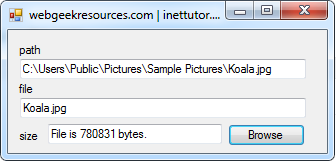

- VB.NET GET FILE PATH FROM FOLDER BROWSER DIALOG HOW TO
- VB.NET GET FILE PATH FROM FOLDER BROWSER DIALOG CODE
Once you've located, simply double-click it and you will see its value change from "true" to "false." By making this value false, you are essentially disabling an enabled line of code that allows sites to mess with your clipboard and block the copy/paste functionality.
VB.NET GET FILE PATH FROM FOLDER BROWSER DIALOG HOW TO
Read Also: How To Find hp Laptop Serial Number Contents1 How To Copy And Paste On HP Laptop1.1 Copy1.2 Cut1.3 Paste1.4 Clipboard2 Video3 FAQs3.1 Step 3: Turn the Value to FALSE. The copy, cut, and paste approach is a common method for moving data between smart devices such as a smartphone or a computer in order to move information swiftly between locations. Technically, you can also go to Edit and scroll down to Paste and Match Formatting or Paste and Match Style, but who wants to go back to that much mouse clicking? On a PC, there’s not a catch-all shortcut that’ll. It’s a lot of keys at once, but it’ll quickly become second nature. Instead of Command + V, hit Command + Option + Shift + V. In the example below, the bottom corner will be used. Step 2.) Players must now select one corner of the structure they want to copy. Place your cursor where you want to paste the copied text and press Ctrl+V.This tool will be used to make the initial selection. Select the text you want to copy and press Ctrl+C. (★) Black Star, (☆) White Star, (⚝) Outlined White Star, ( ) Stress Outlined White Star, ( ) Eight Pointed Black Star, ( ) Eight Spoked. Heart Symbol Star Symbol Aesthetic Symbols Lenny Face Arrow symbol flower symbols Check mark Cool symbol Cute symbols Smileys face Copy and Paste Symbols Copy and Paste Fonts. The copied file will then appear within the opened folder. Click the Paste option that’s adjacent to Explorer’s Copy button. Open a different folder to paste the file in. Press the Copy button on Explorer’s command bar. Open a folder that includes the file you need to copy.Setting all elements of an Array to Null in C# (li.

Selecting Files to Open or Save in VB.NET.If you want to select a Directory instead of a file, look at this post. This setting will cause the dialog to prompt you when you try to save over an existing file.Īfter the ShowDialog call returns OK, use the FileName property to get the filename. I also show OverwritePrompt set to True (which is the default). Many of the properties work the same way as with the OpenFileDialog such as Filter, DefaultExt, and InitialDirectory. You use a SaveFileDialog object instead of a OpenFileDialog object. Saving a file is similar to opening a file. ' InitialDirectory can be omitted to use default, or used to specify an explicit directory In this example, it is not used and defaults to "Open File".Īfter the ShowDialog call returns OK, use the FileName property to get the selected filename. There is also a Title property that can be used to change the name of the Open File Dialog. You can set this property to an explicit path (like "c:\MyData") or you can use the special directories that are defined for you, like: The InitialDirectory property will let you define which directory to open up in. This property also will set the default file extension to use if you don't specify it in the filename (if typed in), so this property can also be used without the Filter property being set. Just specify the extension as a string (with no dot). If you are using Filter with more than one File Type specified, you can also use DefaultExt to specify which File Type to use as the default. If you leave the Filter property empty, then then Open File Dialog will just not have a drop down to select the File Type filter. If you have more than one File Type, you can add another pipe, then another Description|Filter Pattern, and so on. The value is set to a string that is a pipe (|) delimited list composed to a File Type Description and Filter Pattern. The Filter property lets you specify the which File Types will be selectable form the Open File Dialog (in a dropdown list). The OpenFileDialog object is used here, and I have only shown the most commonly used options.

' Do something with the selected filename If fileDlg.ShowDialog() = DialogResult.OK Then ' could be omitted to use default, or a specific dir can be givenįileDlg.InitialDirectory = Environment.GetFolderPath() Here is an example of each:įileDlg.Filter = "CSV File (*.csv)|*.csv|txt files (*.txt)|*.txt|All files (*.*)|*.*" VB.NET has come a long way from the clunky Common Dialog control of VB6 for implementing a standard dialog that will let you browse to find a file to Open or Save.


 0 kommentar(er)
0 kommentar(er)
